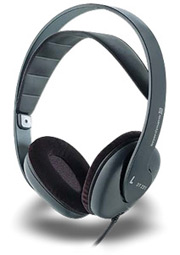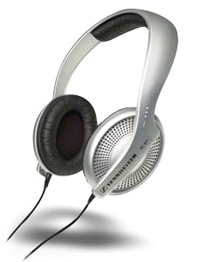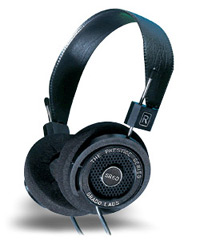Beyerdynamic
DT 231, Sennheiser HD 497, and Grado SR60 Headphones
The ultimate listening experience is when you're
being squeezed between two burly bikers right next to the stage and a muscle-bound
security dude is giving you the evil eye. You've got a cold Pacifico beer in your hands
and the Tailgators are up on the platform wailing away on "Rock and Roll Till the
Cows Come Home." Okay, that's my ultimate listening experience. Unless you're
one of those bikers -- and if you are, I'd like my beanie and thick glasses returned --
then your most memorable experience might well revolve around a live setting when you were
comfortably ensconced in a velvet seat front-row center in an acoustically first-class
auditorium.
That's what we all strive to find: great sound in a
comfortable setting with remarkable music playing. We don't all have the time, money, and
inclination to constantly seek out those sorts of live performances, however. More often
than not, we listen to music in our homes or when we're on the move with a portable
device. And that's where a good pair of headphones can be so handy. They can help
eliminate the distractions of romping kids, barking dogs, honking cars, or a spouse
reminding you that you'd look a lot better if you lost the beanie and goggles.
A lot of headphones provide isolation, allowing you to
block out much of the outside world in order to focus on your music. (Open-air headphones
allow outside noise in. These headphones are designed for maximum comfort, as well as good
sound, but they're not ideal for noisy environments.) In this review, we're going to take
a look at three headphones: the Sennheiser HD 497, Grado SR60, and Beyerdynamic
DT 231. All three are moderately priced cans (between $69 and $89) that provide
varying degrees of isolation for the user. All three are appropriate for use in your home
or on the run with a portable CD or MP3 player, though none is as lightweight as the first
three headphones we reviewed
in September.
Can do: Beyerdynamic DT 231
 These 'phones are a discreet, dark
gray plastic with a self-adjusting, spring-loaded plastic headband. The earpads are fuzzy,
soft, black velour -- quite comfy -- and are a hybrid of open and sealed designs. That
means they'll allow some noise in, though they'll block out a substantial portion of
ordinary noise (kids, dogs, TVs, et cetera). If you're a frequent flyer, beware:
They're not going to be great at blocking out the deep rumblings of jet engines.
Naturally, if a set of cans lets some sound in, it'll also let sound out, so factor that
into your buying decision when choosing headphones. These 'phones are a discreet, dark
gray plastic with a self-adjusting, spring-loaded plastic headband. The earpads are fuzzy,
soft, black velour -- quite comfy -- and are a hybrid of open and sealed designs. That
means they'll allow some noise in, though they'll block out a substantial portion of
ordinary noise (kids, dogs, TVs, et cetera). If you're a frequent flyer, beware:
They're not going to be great at blocking out the deep rumblings of jet engines.
Naturally, if a set of cans lets some sound in, it'll also let sound out, so factor that
into your buying decision when choosing headphones.
The DT 231s do what you ask a good pair of 'phones to
do, though: they reproduce music quite well. When the bell sounds opening up AC/DC's
thunderous "Hell's Bells" (from Back in Black [Atco 92418-2]), the 231s
deliver big, round bass. Is it going to knock you into Angus's lap? No, but it'll knock
you out for the price: $89.
You're just not going to find the ultimate in bass
reproduction for under 100 clams, but the 231s will get the deep, dark moments made by the
bad boys in Metallica and the New York Philharmonic sounding pretty darned good. On David
Bowie's "Moonage Daydream" (The Rise and Fall of Ziggy Stardust and the
Spiders from Mars [Rykodisc RCD 10134]), Mick Ronson's guitar and Trevor Bolder's bass
both land with appropriate heaviness in your ears; same goes for the subterranean dance
beat of Cibo Matto's "Sugar Water" on Super Relax [Warner 9 46478-2].
The Beyerdynamic DT 231s do well at the other end of
the aural spectrum, too. On Etta James's soul-ballad classic, "At Last" (Etta
James: Her Best [MCA/Chess CHD9367]), the high, sweet strings were detailed, and
produced with very little coloration. The same song is also on the reissue of Nat King
Cole's Love is the Thing [DCC GZS-1104], though this version is much less robust
and soulful than James's; again, the sugary strings were as distinct and luscious as one
could hope for at this price.
Will the DT 231s give you the astounding highs and
lows of the audiophile reference Sennheiser HD 600 headphones? Nope. But you're
spending a few hundred dollars less with the 231s; buying audio gear is always a balancing
act between price and performance. Consider this as part of the purchasing teeter-totter:
The DT 231s will kick the little butts of those earbuds lots of folks own. Sure, they
cost more, but they deliver a lot more. Earbuds are like wasps in your ears: small,
uncomfortable, and with stinging highs and buzzing lows.
The 231s, on the other hand, deliver highs and lows
remarkably well, though they're a bit reticent in the midrange. That's unfortunate,
because for most people, much of their music lies in the midrange. Don't misunderstand:
The 231s aren't reticent in the midrange compared to those earbuds or the disposable
'phones that come with portable devices. No, no. They'll deliver gobs more midrange than
those things. What they won't do is emit as much smooth and precisely articulated midrange
as the other two 'phones being reviewed.
Send in the Sennheiser HD 497
 Sennheiser's HD 497s might take
you back to 1968 or so, when "space age" designs were all the rage. These
retro-looking 'phones would look dandy sitting on Ram Dass's head; they're a sleek silver
with lots of small holes in the earpieces, spreading out from the center of the pieces in
concentric circles like ripples from a stone plopped in a pond. The plastic headband is
adjustable, with a one-inch pad on its underside to snug up to your noggin. The pads have
a soft leather-like covering; like the Beyerdynamic 'phones, they're a hybrid of open and
closed designs. So these also let some sound in and out. Sennheiser's HD 497s might take
you back to 1968 or so, when "space age" designs were all the rage. These
retro-looking 'phones would look dandy sitting on Ram Dass's head; they're a sleek silver
with lots of small holes in the earpieces, spreading out from the center of the pieces in
concentric circles like ripples from a stone plopped in a pond. The plastic headband is
adjustable, with a one-inch pad on its underside to snug up to your noggin. The pads have
a soft leather-like covering; like the Beyerdynamic 'phones, they're a hybrid of open and
closed designs. So these also let some sound in and out.
The HD 497s have a suggested list price of $69.95. A
nice little engineering flourish here is with the cable that comes with the ‘phones.
Each earpiece has a separate cable running from it (they join together in a Y about a foot
below the 'phones), and the cables are attached to the earpieces with 1/8" plugs, so
if you ever need to replace the cables, or want to upgrade them, they're easily removed.
These silver cans might look like a souvenir from the set
of Barbarella, but for such affordable 'phones, they serve up great sound across
the spectrum. Highs are clear without being metallic and lows are full and fleshy without
any of the mud of less expensive headphones. Let's tack on a clear addendum here: They
also sound better than a lot of more expensive headphones. All too many more expensive
cans have muddy bottoms, a thin midrange, or pinging highs -- the HD 497s have superb
performance in all three areas.
An album on which the HD 497s shone in particular was Stereophile
magazine's Serenade [STPH 009-2], a live recording of the Santa Fe Chamber Music
Festival, which includes Johannes Brahms's "Horn Trio in E-Flat Major," a
reflective elegy for his mother. (SoundStage! Network scribe Wes Phillips ably served as
assistant engineer on this album.) It's a beautiful piece of music played to
near-perfection by a group of talented musicians, and the Sennheiser HD 497s
reproduced it with remarkable clarity and detail.
They handled the big, bad bass fueling the power-funk of
the title track of Terence Trent D'Arby's Vibrator [Work OK 67070] with equal
eloquence and specificity. These are everyday, every-music 'phones.
But the same caveat that we mentioned above about the
Beyerdynamics headphones applies to the 497s: They don't have the smoothness or lack of
coloration that Sennheiser's own HD 600s give the listener. It's the ol' balancing
act again. At this price, these cans will be an unbelievably good accessory for your
portables and they'll be excellent 'phones for years for your home system, too.
Another caveat before we move on to our third pair of
headphones: Though Sennheiser's HD 497s have excellent sound, I found them a bit
fatiguing to wear for extended periods of time (beyond 30 minutes). I found them somewhat
tight, clamping my poor widdle head a bit too hard. So, if you can, try these cans on for
size before buying.
Oh, what a thrill: Grado SR60
 One of the first albums I listened to
when auditioning Grado's SR60 'phones, from their Prestige line, was the Mavericks' What
a Crying Shame [MCA MCAD-10961]. I skipped ahead of the first eight songs and tested
these tried-and-true cans (they've been around for eight years or so) on "Oh, What a
Thrill." One of the first albums I listened to
when auditioning Grado's SR60 'phones, from their Prestige line, was the Mavericks' What
a Crying Shame [MCA MCAD-10961]. I skipped ahead of the first eight songs and tested
these tried-and-true cans (they've been around for eight years or so) on "Oh, What a
Thrill."
"If Raul Malo's voice doesn't break my heart when I've
got the Grados strapped to my head, I'll tear 'em to shreds on GoodSound!" was
what I thought. (I didn't think it with an exclamation mark -- that's just part of the GoodSound!
name. See?) Result: heart broken, cans given glorious recommendation.
They're simply extraordinarily fine accessories for either
your home system or portable listening stuff. These babies will give you plenty of tight,
clean bass when plugged into your home-system's headphone jack and even when tapped into a
Walkman or a Nomad MP3 player, but the bass gets even more detailed when you jack 'em into
a dedicated headphone amp like HeadRoom's Supreme. The midrange is smooth and strikingly
free of coloration, while treble is like Diana Ross reaching for a high note way back
when: superfine.
If you're one of those people who really spend a lot of
time listening to music via headphones, take heart: these babies are comfy, if not
Euro-stylish. The $69 Grados are simple, well-constructed supra-aural 'phones (on-the-ear
rather than over-the-ear) that come in basic black with a flexible, adjustable headband.
The earpieces are covered with big, soft, black foam pads that remain comfortable against
your acoustic organs for about as long as you can stand to listen to music.
Like the others, the Grados don't quite make the grade when
stacked up against those reference cans from Sennheiser, but they're nevertheless an
excellent pair of headphones that should do you and your music right as far into the
future as you care to cast your eye.
Recommendation
All three of these headphones will make most folks happy
with what they hear from 'em. Our favorite among the three are the Grados, however. They
passed every musical test, from Mozart to Iron Maiden to Rasputina to Willie Nelson to
Zoot Sims. As far as this trio of affordable headphones goes, they gave us the biggest
thrill.
Our heartiest recommendation is for you to audition any of
these. They're all worth a listen.
Prices of equipment reviewed
The reviewed headphones are available at HeadRoom.
|